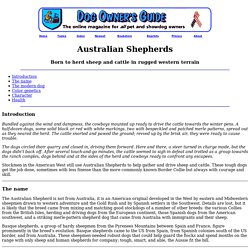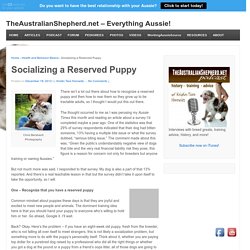

DogSpeak: Improving communication between you and your canine Article. How to Interpret Your Dog's Body Language, Facial Expressions and Vocalizations. Dog Body Language: Eyes, Ears, Tails, and More. Dogs are very expressive animals.

They communicate when they’re feeling happy, sad, nervous, fearful and angry, and they use their faces and bodies to convey much of this information. Dog body language is an elaborate and sophisticated system of nonverbal communication that, fortunately, we can learn to recognize and interpret. Once you learn how to “read” a dog’s postures and signals, you’ll better understand his feelings and motivations and be better able to predict what he’s likely to do.
These skills will enable you to interact with dogs with greater enjoyment and safety. It helps to first learn about the various components that make up dog body language. Victoria Stilwell Positively. Home >> Dog Training >> Understanding Dogs >> Canine Body Language Because dogs don't speak our language, the only way to truly comprehend and communicate with them is for us to understand and appreciate what they are telling us through their body and vocal language.

Often, gestures or actions that we assume mean one thing are actually the dog telling us the exact opposite, and determining what that wagging tail or exposed tummy really means can sometimes be the difference between a belly rub and a bite. Dogs communicate using a complex language of body signals that reflect what they are thinking and feeling.
The Pet Professional Guild - Dog Body language. Signs of Anxiety These signs indicate that your dog is uncomfortable with the current situation and there is a need for intervention to prevent pushing the dog to the point of biting, and to make sure your canine friend is happy and not feeling anxious.

One Paw Raised This is very cute but the dog is not happy and does not want to be petted or bothered. She is worried. Half Moon Eye. Reading Canine Body Language. Nervous Dog Behavior - Avoidance & Collar Anxiety. As my family of five (2 humans, 2 dogs and a bird) prepares for our big move, a lot of to-do’s are popping up.

One big category on the list is dog training. Because we will likely go into a temporary rental situation prior to finding our next property, the dogs need to be able to demonstrate proper manners and social skills. Australian Shepherd, Dog Body Language and Aussies. Dog Owner's Guide Profile: Australian Shepherd. Born to herd sheep and cattle in rugged western terrain Introduction Bundled against the wind and dampness, the cowboys mounted up ready to drive the cattle towards the winter pens.

A half-dozen dogs, some solid black or red with white markings, two with bespeckled and patched merle patterns, spread out as they neared the herd. The cattle snorted and pawed the ground; revved up by the brisk air, they were ready to cause trouble. Socializing a Reserved Puppy - TheAustralianShepherd.net - Everything Aussie! There isn’t a lot out there about how to recognize a reserved puppy and then how to rear them so they grow up to be tractable adults, so I thought I would put this out there.

The thought occurred to me as I was perusing my Aussie Times this month and reading an article about a survey I’d completed maybe a year ago. One of the statistics was that 29% of survey respondents indicated that their dog had bitten someone, 13% having a multiple bite issue or what the survey dubbed, “serious biting issue.” The comment made about this was, “Given the public’s understandably negative view of dogs that bite and the very real financial liability risk they pose, this figure is a reason for concern not only for breeders but anyone training or owning Aussies.”
Which Emotions Do Dogs Actually Experience? Most people can read emotions in their dog quite easily.

For example, you come home and your dog dances around wagging her tail, and you think to yourself, “Lady is happy to see me,” or “Lady really loves me.” Or perhaps you’re out on a walk and, at the approach of another canine, your dog freezes in place, his hackles raised, and gives a low throaty growl. We interpret this as “Rex does not like that dog. Seeing him makes Rex angry.” Dog Body Language. SEE ALSO: ABCs of Dog Life, Getting The Behavior You Want From Your Dog, Meeting Fearful Dogs Safely, Staying Safe Around Dogs Just like people, dogs communicate using “body language.”

Your dog is communicating with his entire body, not just his tail or his voice. If you want to know how he is feeling, you’ll need to learn to read your particular dog’s body language. To get a sense of what your dog is trying to tell you, spend as much time as you can observing your dog and his body posture. How To Read Your Dog's Body Language. What is your dog trying to tell you?

Dogs have a language that allows them to communicate their emotional state and their intentions to others around them. Although dogs do use sounds and signals, much of the information that they send is through their body language, specifically their facial expressions and body postures. Understanding what your dog is saying can give you a lot of useful information, such as when your dog is spooked and nervous about what is going on, or when your dog is edgy and might be ready to snap at someone. You do have to look at the dog's face and his whole body. Canine Body Language. Dogs are very expressive animals.

They communicate when they’re feeling happy, sad, nervous, fearful and angry, and they use their faces and bodies to convey much of this information. Dog body language is an elaborate and sophisticated system of nonverbal communication that, fortunately, we can learn to recognize and interpret. Once you learn how to “read” a dog’s postures and signals, you’ll better understand his feelings and motivations and be better able to predict what he’s likely to do.
These skills will enable you to interact with dogs with greater enjoyment and safety. John Bradshaw On The New Science Of Understanding Dog Behavior. Hide captionDr. John Bradshaw is an anthrozoologist and a noted scholar of animal-human interactions. Basic Books Dr. John Bradshaw is an anthrozoologist and a noted scholar of animal-human interactions. Dog Sense: How the New Science of Dog Behavior Can Make You a Better Friend to Your PetBy John BradshawHardcover, 352 pagesBasic BooksList price: $25.99. Animal Behavior - Dog and Cat Body Language at WomansDay.com. While a dog's wagging tail is usually interpreted to be a sign of playfulness, it's the complete opposite for a cat. "If they are moving the tail from side to side, the faster it's going, the more upset they are," says McMillan Loehr. Dr. Burch agrees, adding that it also matters how the tail is positioned.
"The cat's tail is like a feline mood ring," she says. Animal Behavior. Positive Dog Parenting. What is Canine Communication? Imagine this scenario. Your dog barks at something outdoors, waking you up. You get up reluctantly, and tell your dog off with clear annoyance in your voice tone, staring at your dog feeling stiff. Reading Cat and Dog Body Language. Can cats and dogs ever be friends? Some can, while others will fight like — well, like cats and dogs. Why the inconsistency? Read Your Dog’s Body Language. The movie Up features a dog with a collar that translates his thoughts into sentences like "I have just met you, and I love you! " Real dogs, however, speak more with body language than with barks. "While there are fewer than a dozen types of barks, there are hundreds of different ear positions, tail positions, paw positions and more, which dogs use to communicate," says Lisa Mullinax, CPDT-KA (certified professional dog trainer-knowledge assessed), for 4Paws University Inc.